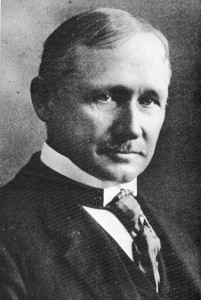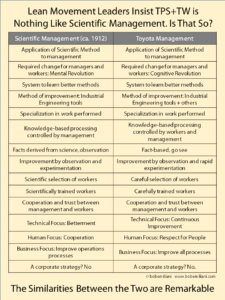
Every day, thousands of people confuse Lean management with “Taylorism,” properly known as Scientific Management. The negative association brings out those who work hard to create a great separation between Lean and Taylor. This is an ill-informed and inappropriate response. It is also an irresponsible response because it misleads people. The leaders of the Lean movement, in particular, should not mislead people through their own prejudice and ignorance. And those who speak loudest about “Respect for People” are quick to shower Frederick Winslow Taylor with disrespect and other forms of disdain and mistreatment.
Taylorism has been a heavy anchor around Lean’s neck for more than 30 years, and it will continue to be unless a wiser strategy is undertaken in response to confusion between Scientific Management and Lean management. Rather than trying to paint Frederick Winslow Taylor as a villain, which he was not, the smarter and more accurate action is to respect Taylor and recognize him for his accomplishments and how his work, and that of his colleagues, were necessary first steps in the evolution of progressive management that helped pave the way for Toyota’s management system decades later. Toyota made use of Taylor’s time studies, Frank and Lillian Gilbreth’s motion studies, standard work, and other important practices that form the bedrock of the industrial engineering methods used in kaizen and which, in turn, resulted in huge productivity improvements at Toyota that helped propel them to where they are today.
Here is why you should respect Taylor as much as you respect Henry Ford and Taiichi Ohno. Taylor came from a wealthy family, but instead of taking the easy path he became an apprentice patternmaker and machinist. He worked his way up from the shop floor to supervisor. So, from his years of experience in the shop, he knew well the machining trade, how workers worked, and how they sometimes did not work. It is here that Taylor began to develop his system of management – by getting his hands dirty on the shop floor and then putting his ideas into practice, via experimentation, in collaboration with the workers that he supervised. Based on this work, Taylor was later credited with creating a new technical discipline called Industrial Engineering.
What do Lean people value and respect in a person? Hmmm, let me think: Getting your hands dirty, knowing the job, doing experiments using the Scientific Method (and its derivative forms), collaborating with workers (teamwork). Taylor thought the shop floor was where learning took place and experiments were the best means by which problems could be solved. Sound familiar? Keep these things in mind as you read on. From there, Taylor worked his way up to become an executive. Later, Taylor and his steel company colleagues did years of careful experiments on the composition and heat treatment of tool steels, which led to an immensely useful invention called “high-speed steel.” The royalties from patents for high-speed steel made Taylor a wealthy man. Taylor was a fact-based person, skilled in engineering and experimentation, persuasive in getting people to try new things, an inventor, the developer of a comprehensive new system of progressive management based on the Scientific Method, and the father of industrial engineering. Don’t run away from Taylor; take pride in him and his work! It strengthens Lean management, not weakens it.
The high-speed steel invention and, later, the book The Principles of Scientific Management made Taylor internationally famous. But it also earned him some unwanted notoriety. Managers in the U.S. who read his book adopted only pieces of Scientific Management, not the system in its entirety. Taylor’s camp advocated for REAL Scientific Management (“Betterment” and “Cooperation”), while business leaders adopted Fake Scientific Management (“Betterment”). Sound familiar? The practitioners of Fake Scientific Management were called “fakirs,” “quacks,” “cranks,” and “charlatans” by Taylor’s associates. The widespread adoption of Fake Scientific Management by managers in industry got Taylor into trouble, and he was summoned to testify before a Congressional subcommittee in January of 1912 to explain the Taylor system. He did that, and also patiently and eloquently explained the difference between Fake Scientific Management and REAL Scientific Management. Taylor’s testimony provided many memorable quotes, including this one: “It ceases to be scientific management the moment it is used for bad.” We can say the same about Lean management today.
Taylor’s book, The Principles of Scientific Management, was translated into many languages, including Japanese, and was a very popular book in Japan. It was adopted by Japanese business leaders in the spirit that Taylor had practiced himself and which he had intended: REAL Scientific Management (“Betterment” and “Cooperation”). The existence of Fake Scientific Management was far less prevalent in Japan than in the United States.
Judging Taylor’s work in the 1880s against the current standard, Toyota, is thoughtless. Further, Taylor and Ohno were trying to solve different problems in different eras, through the methods for doing so had considerable overlap. Taylor faced a sellers’ market while Ohno faced a buyers’ market. Taylor was concerned about underproduction while Ohno was concerned about overproduction. Both Taylor and Ohno wanted lower-level people to make improvements based on facts instead of opinions – especially the opinions of people who had power (“the boss”). Both Taylor and Ohno wanted to improve productivity and reduce costs. And Both wanted to create what Ohno would later call the “full work system” (see Ohno, Toyota Production System, pp. 59-60).
When Taylor is vilified today, what is he vilified for? It is only two things. First, his approach to determining standards (standard work). He thought standards were best determined by an educated person (an engineer) specifically trained to do this type of job (i.e. time and motion study, with a stopwatch), and that there was “one best way” to do the work. The second was his view towards workers, which seemed harsh due to the words that Taylor used to describe workers in his writings and the manner in which they sometimes curtailed output, called “soldiering” (Ohno called it “waste;” i.e. waiting or idle time). So, despite the many benefits of the “Taylor system” compared to the conventional (zero-sum, win-lose) management practice of the day, it is these two things that people remember most and for which they vilify him today. But is right to vilify him for these two things?
No, it is not. And here’s why. In the early development of progressive management, Taylor’s rationale for who should create standards was sensible and appropriate, and his view of workers was actually progressive for the times. It was far less harsh than the way most managers viewed both work and workers. In fact, Taylor’s views on standards (see pages 14 and 68-69 for an explanation) and workers was revolutionary for the day and far more humane and remunerative than was typically the case. Further, Taylor’s work evolved after his death in 1915 at the age of 59, to be more inclusive of worker input, and the “one best way” gave way to “continuous improvement.” The flow production system created by Frank George Woollard (ca. 1925) in the U.K., was influenced by both Taylor and Ford, and had as its principles, “Continuous Improvement” and “Benefit for All.” The Toyota Way principles, “Continuous Improvement” and “Respect for People,” are directly traceable back to Taylor’s work.
To understand Taylor’s view towards workers and society, read the 13-page paper, “The Spirit and Social Significance of Scientific Management” by Morris Cooke (1913). The most concise explanation of the controversies surrounding Taylor’s work is found in a small, 103-page book titled, Primer of Scientific Management by Frank Gilbreth (1914). To clearly understand the difference between REAL Scientific Management and Fake Scientific Management, read Taylor’s lengthy January 1912 testimony to Congress. Like Lean management, Scientific Management is difficult to comprehend, and those who don’t study it thoroughly and carefully will surely misunderstand it as well as Taylor.
To understand Scientific Management, you have to read a large body of work, not solely Taylor’s two papers (“A Piece-Rate System [1895] and “Shop Management [1903]) and his 1911 book, The Principles of Scientific Management. One must begin with works by the (mechanical) engineers that preceded Taylor (e.g. Henry Towne), as well as the works by Taylor’s contemporaries (mainly business owners, some consultants, and a few academics). These authors include Morris Cooke, Frank Gilbreth, Dr. Lillian Gilbreth, C. Bertrand Thompson, Henry Farquhar, Carl Barth, Horace Drury, Harlow Person, Henry Gantt, James Dodge, Henry Kendall, Horace Hathaway, Harrington Emerson, Charles Going, Dexter Kimball, Hugo Diemer, and so on, as well as the works by industrial engineers that followed them such as Ralph Barnes and George Shepard (principally in the 1930-1945 time frame, and which includes Training Within Industry). You also have to read Taylor’s detailed biography written by Frank Copley. There were some 60 major works published on the subject of Scientific Management from between 1880 and 1935, and I own them all and I have read them all (that’s what professors do). Lastly, you must be aware that interpretations of Taylor’s work by academics – economists, social scientists, and even some historians – post-1945 is often incorrect in terms of Taylor’s intentions, the Scientific Management system itself, its intended outcomes, and the treatment of workers.

The poor understanding that they have about Taylor and of Scientific Management suggests that they have done no research, little research, or poor research on this important topic. Or, they cherry-pick the two negatives to satisfy some ulterior motive. If it is the latter, then that is obviously reprehensible. If it is the former, then one wonders about the quality of the research that they have done regarding TPS and The Toyota Way. Did they cherry-pick the good stuff to gain a wider audience? Toyota has been far from flawless when it comes to “Respect for People.” It is not difficult to find two noteworthy flaws and loudly amplify them as others have done to Taylor. Nobody and no management system is perfect, and to idealize them is to mislead and deform the truth.
The job of advancing progressive Lean management is made far more difficult, and likely imperils the existence of Lean, if misconceptions about Scientific Management are allowed to persist. So it is in Lean movement’s best interest to respect Taylor, to embrace Taylor, and to correct misunderstandings about him and his work. To do otherwise is to be a Lean hypocrite: respect some pioneers of progressive management while disrespecting others – and for reasons that are not fact-based. Taylor possessed the characteristics valued by Lean people: Hard work, get your hands dirty, know the job, do experiments scientifically, be creative, collaborate with workers, and create better (non-zero-sum, win-win) outcomes for employees, customers, investors, and society at-large (i.e. humanity).
I am certain that Taylor, were he alive today, would be mystified at how people have remained stuck on two misinterpretations of his work (and Fake Scientific Management), the effort that people put into vilifying him, and how the great work of those who built on Taylor’s work, from 1915 through the 1950s, is so poorly understood, both on its own and in relation to Toyota’s management system. Toyota did not invent their management system all by themselves. They built on the work of others and made many very important contributions for which their admiration and recognition are well-deserved. Taylor’s work is part of the lineage of Toyota’s management system. It is the foundation of Lean management. Will the they acknowledge and correct their error for the sake of advancing Lean management? We will see.
